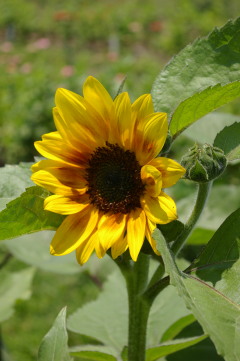Helianthus ‘#565’
go.ncsu.edu/readext?221343
en Español / em Português
El inglés es el idioma de control de esta página. En la medida en que haya algún conflicto entre la traducción al inglés y la traducción, el inglés prevalece.
Al hacer clic en el enlace de traducción se activa un servicio de traducción gratuito para convertir la página al español. Al igual que con cualquier traducción por Internet, la conversión no es sensible al contexto y puede que no traduzca el texto en su significado original. NC State Extension no garantiza la exactitud del texto traducido. Por favor, tenga en cuenta que algunas aplicaciones y/o servicios pueden no funcionar como se espera cuando se traducen.
Português
Inglês é o idioma de controle desta página. Na medida que haja algum conflito entre o texto original em Inglês e a tradução, o Inglês prevalece.
Ao clicar no link de tradução, um serviço gratuito de tradução será ativado para converter a página para o Português. Como em qualquer tradução pela internet, a conversão não é sensivel ao contexto e pode não ocorrer a tradução para o significado orginal. O serviço de Extensão da Carolina do Norte (NC State Extension) não garante a exatidão do texto traduzido. Por favor, observe que algumas funções ou serviços podem não funcionar como esperado após a tradução.
English
English is the controlling language of this page. To the extent there is any conflict between the English text and the translation, English controls.
Clicking on the translation link activates a free translation service to convert the page to Spanish. As with any Internet translation, the conversion is not context-sensitive and may not translate the text to its original meaning. NC State Extension does not guarantee the accuracy of the translated text. Please note that some applications and/or services may not function as expected when translated.
Collapse ▲Trial: Annual
Year Trialed: 2008

Good Qualities
Beautiful bicolor blooms (8), although shading of bicolor wasn’t uniform; Good stem caliper (2); Strong stem/neck; Quick to produce new usable stems after cuts; 6-8 inch flowers, among earliest in group to flower, tendency toward branching so that secondary flowers can be harvested if primary flower is cut short, lots of ooohs and aaaahs on this one; Healthy and productive; Smaller heads were 5 in. in diameter and they worked well in arrangements; The newer cultivars of sunflowers that keep appearing each year are an incremental improvement over the older cultivar and ‘565’ is typical of that change, nice presentation and has a more upright appearance longer; Easy to grow, good bloom and stem size; Good plant height, not too bushy.
Problems
None; We hand planted our trial sunflowers and #565 was indistinguishable from ‘Sun4U Bicolor’; Small bloom for size plant, tendency for petals to bend backwards as they age; Side shoots very fragile, susceptible to breakage even of the slightest touch; Vase life not quite as good as other cultivars; The large head was about 10 in. in diameter and it did not work well in arrangements; This one was of no use to me, no height, small inferior bloom; I really could not distinguish between any of these cultivars, or maybe I should say the differences were more subtle than I could see-I think that they were too large, really thick stems, big heads even when direct seeded; Good flower color pattern (brown ringed center) when the flower opens but as the flower fully opens, the brown ring fades away.
Similar Cultivars
‘Sun4U Bicolor’ (5), appeared almost identical; Many; Looked a lot like the Sunbright series.
Comments
Fine, not worth switching to; Did not know it was branching, but was delighted to get a later usable flush of 2-3 (24-30 inch) side shoots, perfect in bouquets!; 1 large head at 10 inches and 5 small heads at 5 inches; Harvested between 7/25-8/20 (direct seeded on May 28); Appears to be moderately sensitive to daylength: short day reaction; Would trade Sunrich or Sunbright series for any of them; The Agridera submissions from Gloeckner all did well and had similar characteristics, the yellow orange petals with brown disk were all similar in the group; Flowered around August 1 (sowed June 11, transplanted to field June 25), flower diameter 7.5 in. when fully open, medium stem thickness.
Postharvest
Bleach and water; Keep the vase solution clean; Remove leaves; We only used plain water.
See separate postharvest report for results from NC State University postharvest evaluations.
Trial Data
| Yield (stems/plant) | Stem Length (inches) | Market Appreciation Rating¹ | Repeat Again Rating¹ | Ease of Cultivation Rating¹ | Average Spacing (in2) | Average Postharvest Life (days) |
|||
|---|---|---|---|---|---|---|---|---|---|
| Wholesale | Retail | Consumer | |||||||
| Average | 1.7 | 36.6 | 3.0 | 3.4 | 4.0 | 3.4 | 4.5 | 128 | 8.6 |
| Range of Responses | 1-5 | 28-66 | 2-4 | 4-5 | 2-5 | 1-5 | 3-5 | 36-648 | 8-12 |
¹1 to 5 scale, with 5 being the best. Market ratings are based on sales to wholesalers, retailers, or final consumers direct.
Supplier
Fred C. Gloeckner Company
600 Mamaroneck Ave.
Harrison, NY 10528-1613
Agridera Seeds & Agriculture Ltd.
Gedera, Israel


